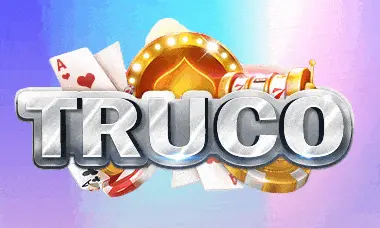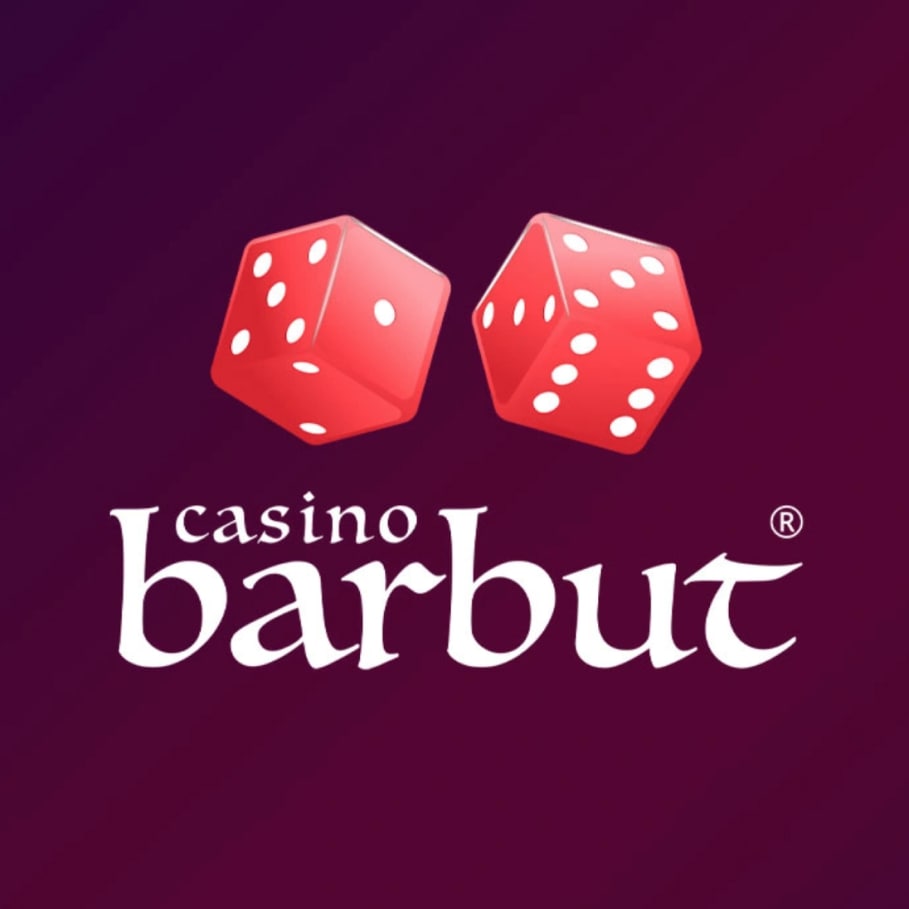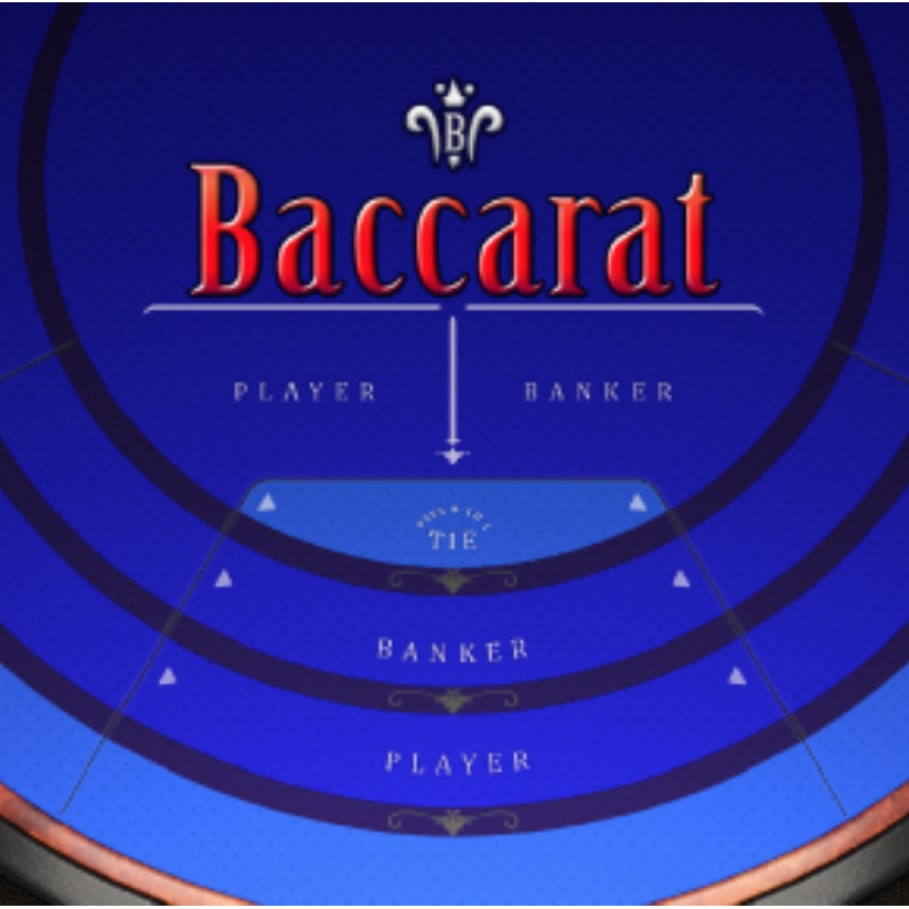A Primer on the Shotgun The Art of Manliness
The shotgun is the perfect weapon for home defense and disaster prep. It’s powerful, reliable, and versatile.

Recently I’ve had the itch to buy a shotgun. It started after I read Creek’s post on how to build a survival shotgun. The itch only grew stronger after I became a homeowner (I kind of feel like Kevin McAllister). The shotgun is the perfect weapon for home defense and disaster prep. It’s powerful, reliable, and versatile. You can use it to fend off home intruders, hunt for food, or even shoot skeet with your buds.
But as I’ve discussed before on the site, I’m a complete novice when it comes to guns. I grew up around them, but I just didn’t take an interest in them until recently. Before I brought a shotgun into my house, I wanted make sure I knew how it worked and how to fire it safely and correctly.
So I headed over to the U.S. Shooting Academy here in Tulsa, OK to talk to Mike Seeklander, President of the Academy and co-host of Outdoor Channel’s The Best Defense. Mike’s helped me out before with articles on how to fire a handgun and a rifle. On this trip, he explained the very basics of understanding and firing a shotgun. Today I’ll share what I learned from Mike for those folks out there who are also interested in becoming first-time shotgun owners.
Types of Shotguns
 Mike’s pump-action and semi-automatic shotguns
Mike’s pump-action and semi-automatic shotguns
Shotguns are fired from the shoulder and are typically used to hit targets at short distances. Unlike rifle and handgun cartridges that can only fire a single projectile, a shotgun cartridge typically fires multiple pellets called “shot” that spread out as they leave the shotgun’s barrel. Because the power of a single cartridge charge is divided among multiple pieces of shot, the energy of the shot decreases greatly as it travels away from the gun. That’s why shotguns are short-range weapons.
There are a variety of shotguns out on the market that serve different purposes. Below we highlight the most common types.

Break-action shotguns. Break-action shotguns have a hinge between the barrel and the stock that allows you to “break” or open the barrel to expose the breech in order to load your ammo. If you’ve ever seen pictures of old big game hunters or cowboys holding a shotgun, they were probably holding a break-action shotgun. Break-action shotguns are usually double-barreled, with the barrels either side-by-side or placed one on top of the other. They’re typically used by hunters and sport shooters. The big disadvantage of break-action shotguns is that they’re single shot guns, meaning once you fire the single round in each barrel, you have to reload.
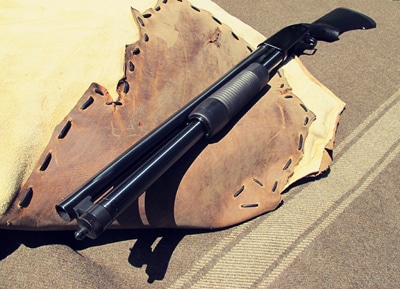 Mossberg 500 pump-action shotgun
Mossberg 500 pump-action shotgun
Pump-action shotguns. A pump-action shotgun is a single-barrel shotgun that holds multiple rounds (unlike break-action shotguns). The way you extract spent shells and chamber a fresh round is by pulling a pump handle towards yourself, and then pushing it back into its original position along the barrel. Pump-action shotguns are widely used by police forces around the world because of their reliability and ability to hold multiple rounds. The Remington 870 has been the standby shotgun for American police forces for years, while the U.S. military has been partial to the Mossberg 500.
The general consensus in the firearms community is that pump-action shotguns are the top choice for home defense. They’re relatively easy to use, nearly impossible to break, and are super reliable. More importantly, the sound of chambering a hot round into a pump-action 12 gauge is sure to soil the britches of even the most hardened criminal. As an added bonus, they’re relatively cheap, with prices beginning around $200.
One of the things you have to watch out for when firing a pump-action shotgun is short-stroking. That’s when you don’t push the pump all the way back to its original position, resulting in a failure to chamber the next round in the magazine.
 Browning semi-automatic shotgun
Browning semi-automatic shotgun
Semi-automatic shotguns. A semi-automatic shotgun fires a single shell each time the trigger is pulled, automatically ejects the spent shell, and automatically chambers a new shell from a magazine. This allows you to fire off shots quickly. Some states ban hunting with semi-automatic shotguns, so be aware of that if you plan on using your gun to hunt.
Because rounds are automatically loaded and the design is more complex, semi-automatic shotguns are more prone to jamming failures than pump-action or break-action shotguns.
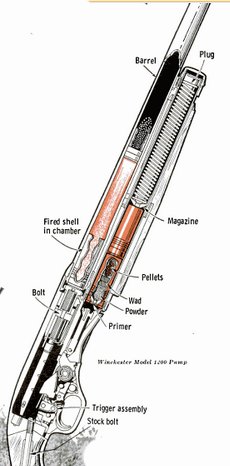 Diagram of a shotgun
Diagram of a shotgun
Understanding Shotgun Ammo
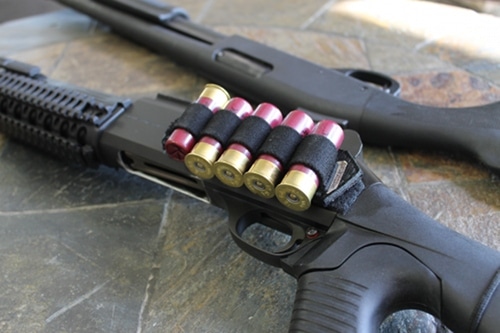
Shotgun ammo is broken down into three categories: birdshot, buckshot, and slugs.
Birdshot. Birdshot is smaller than buckshot and is used primarily for hunting, you guessed it, birds. Birdshot size is categorized by a number: the larger the number, the smaller the shot. The smallest birdshot is #12 shot and the largest is size FF. All birdshot pellets have a diameter smaller than 5 mm. Birdshot is so small it’s simply poured into a shotgun shell until the shell reaches a certain weight.
Buckshot. Buckshot is typically used for hunting small to medium-sized game and for police and home defense purposes. As with birdshot, the buckshot is categorized by a number that decreases as the size of the shot goes up. The smallest buckshot is #4 and from there the sizes go past #1 to 0000 (quad-ought), 000 (triple-ought), 00 (double-ought), and 0 (ought). Unlike birdshot, buckshot is too large to be poured into a cartridge. Rather, the buckshot pellets are stacked into the shell in a fixed geometric arrangement in order to fit.
Slugs. Slugs are basically a giant bullet. Instead of firing multiple pellets, a shotgun shell with a slug in it only fires a single slug. Slugs are primarily used to hunt large game and for military and police purposes. Slugs are rifled which gives them spin as they leave the barrel of the gun, making the slug much more accurate and stable in flight.
Understanding Gauge, Chamber Length, & Choke Tubes
Gauge
Unlike handguns and rifles that use caliber to measure the diameter of the barrel, shotguns use gauge. Measuring gauge goes back to the days of muzzle-loading guns. A shotgun’s gauge number is determined by the number of lead balls that are the size of the gun bore’s diameter that can roll down the gun’s barrel to make a pound. So for example, in a 12 gauge shotgun, twelve lead balls with a diameter equal to the diameter of the barrel adds up to one pound.
Confused? Don’t worry. It takes a bit to wrap your head around it. Just remember this: The smaller the shotgun gauge number, the larger the barrel; the larger the barrel, the bigger the boom from your boomstick.
The most common shotgun gauge sizes are: 10 gauge = .775 inch, 12 gauge = .729 inch, 16 gauge = .662 inch, 20 gauge = .615 inch, 28 gauge = .550 inch.
The 12 gauge shotgun is the most common shotgun gauge sold in America and is a good all-purpose gun — great for home defense, hunting, and skeet shooting. Because of their widespread use, ammo and accessories for 12 gauge shotguns are much easier to find than for other size shotguns. If you’re going to use your shotgun primarily for hunting or skeet shooting, you might follow the advice of shotgunning expert Bob Brister and go with a smaller gauge gun like a 20 or 28 gauge.
Chamber Length
In addition to a shotgun’s gauge number, another size you’ll see stamped on a shotgun’s barrel is the chamber length. The chamber is where the shell fits into the gun for firing. You need to make sure the length of the shell you’re loading into your gun matches the chamber length on your shotgun. Firing shells that are longer than the length of the chamber can generate dangerously high pressures in your gun. That’s a big safety risk.
Choke Tubes
As we mentioned earlier, when you fire a shotgun, the pellets in the shell spread as they leave the gun. When the pellets hit their target, they leave a spread pattern. Spread patterns can be small and dense or wide and sparse. The closer you are to your target, the more compact and lethal your spread pattern.
If you want to maintain a dense spread pattern when firing your shotgun at long distance targets (like you would when hunting), you’ll want to use a choke tube. A choke tube constricts a gun’s shot charge to hold it together longer before the shot spreads, thus giving a denser shot pattern at longer range than an open choke or no choke at all. Choke tubes come in a variety of sizes depending on how dense a pattern you want. If you’re simply using your shotgun for home defense, you probably don’t need a choke tube. They’re mainly used by hunters and skeet shooters.
How to Stand When Firing a Shotgun
Now that we’re familiar with the anatomy and workings of a shotgun, let’s get down to how to fire it. But first, please review the four cardinal rules of firing a gun.
Mike and the folks at the U.S. Shooting Academy teach their students to assume an athletic stance when firing a shotgun. Square your shoulders up with the target. Stand with your feet shoulder-width apart on a straight line. Stagger your strong-side foot about six inches behind your weak-side foot.
Place the buttstock of the shotgun near the centerline of the body and high up on the chest. Keep your elbows down.
Here’s Mike showing the athletic stance:
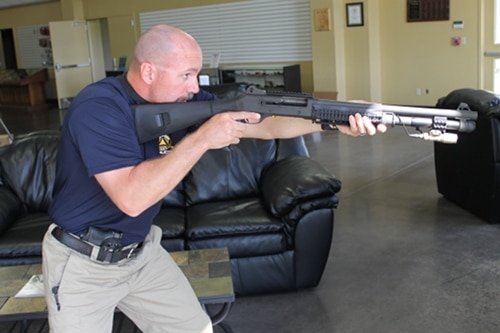
The biggest advantage of the athletic stance over the bladed stance (standing sideways) is that it helps in reducing the effects of recoil when firing a shotgun. Think about it. If you’re a lineman in football and you want to resist the other guy pushing you backwards, what stance would give you more balance? Being squared up with the other guy, or standing sideways with just one of your shoulders towards him? Squared up, of course.
Another advantage of the athletic stance is that it allows you to track a moving target better.
How to Hold a Shotgun
The act of putting a shotgun to your shoulder is called mounting the gun. But you don’t bring the gun to your shoulder straight off. You want to bring the side of the stock to your cheek first, before moving the buttstock to your shoulder.
Keeping your head up, bring the shotgun to your head. Press your cheek firmly to the side of the stock and then place the buttstock of the shotgun near the centerline of the body and high up on the chest, like so:
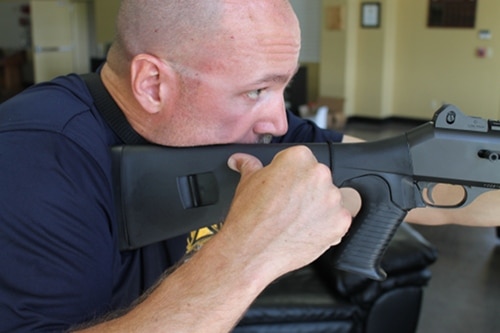
Trigger Hand Grip
On most shotguns you’ll find a crook between the stock and the trigger guard. Simply center the crook in the “V” junction of your thumb and index finger of your trigger hand. Grip the gun firmly, but not tightly.
If your shotgun has a pistol grip like Mike’s gun in the picture below, center the grip in the “V” at the junction of the thumb and index finger of your trigger hand. Grip the gun high on the backstrap (the backstrap is the back of the grip on the gun). Like so:

Support Hand Grip
The support hand should grip the fore-end of the shotgun roughly midway down the length of the shotgun. Here’s Mike demonstrating for us:
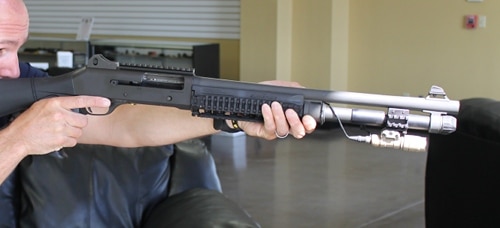
Putting your support hand further forward on the fore-end will give you finer control over the muzzle when aiming, which you want when precision is key. It will also give you more leverage against the gun which helps in recoil control.
How to Hold a Shotgun in Close Quarter Situations
You’ve probably seen movies where the action hero fires a shotgun in close quarters from the hip. I asked Mike about that.
“That’s a great technique…for the movies,” he said.
In other words, don’t use it in real life. It’s not safe and doesn’t provide any advantages other than looking cool.
If your target is really close to you, Mike suggests bringing the shotgun stock beneath your armpit in order to create more space between you and your target while maintaining more control. Here’s how it looks:

How to Aim a Shotgun
There’s a lot of debate among shotgunners about how you’re supposed to aim these things. You’ll hear many folks say, “You don’t aim a shotgun, you point it,” (See Shotgunningby Bob Brister.) Others will say you should aim it just like you would a rifle.
I asked Mike about this, and he said that while you should definitely aim a shotgun, the way you aim will be different depending on what sort of situation you’re in.
“You’re responsible for every shot you fire, so you better be sure you know where they’re going,” Mike advises. “Don’t just point it and start firing action movie style.”
Aiming a Shotgun in Home Defense and Large Game Hunting Situations
If you’re using a shotgun in a home defense situation or if you’re hunting deer with slugs, you’ll want to aim your shotgun just like you would when firing a rifle. Some shotguns have a rear sight notch and a bead at the end of the gun’s barrel (most shotguns don’t have a rear sight). Align those just as you would with a rifle. After you have proper sight alignment, you’ll want to set your sight picture. I talked about proper sight picture in our post about firing a handgun. The same principles apply here. I won’t repeat what I wrote, so refer back to that post for tips on aiming a shotgun.
Aiming a Shotgun in Small Game Hunting or Trap Situations
When you’re bird hunting or shooting skeet, you don’t have time for the deliberate aiming technique described above. If you try to aim like that, your bird will be long gone before you get a shot off. When you’re hunting small, fast-moving game or shooting clays with a shotgun, instead of carefully lining up your sights and putting all your focus on them like you would with a rifle, simply focus on the target, and fire.
“You also need to lead the target when firing at fowl. Don’t focus on the target itself, but rather the target’s front edge,” says Mike.
Trigger Management (aka Pulling the Trigger)
Unlike with a rifle or handgun where you slowly squeeze the trigger, with a shotgun you can use a more direct and less controlled trigger press. Again, when firing a shotgun, speed in getting off a shot is the goal.
Practice, Practice, Practice
The key to successful and safe gun training is practice. If you don’t own a shotgun, but are interested in purchasing one, find a local gun range and rent one for an hour. Ask to have someone show you how to fire it safely and correctly. Most places will be more than happy to help. If you already own a shotgun, here’s a friendly reminder to keep training.
Oh, and if you’re curious as to what sort of shotgun I ended up getting. It’s a Remington 870 Express.
Do you own a shotgun? Have any other tips for the first-time shotgun shooter? Share them with us in the comments!
Editor’s note: This article is about understanding the shotgun and how to fire one safely and correctly. It is not a debate about gun rights or whether guns are stupid or awesome. Keep it on topic or be deleted.
_____________________________________________________________________________
Special thanks goes out to Mike and the crew at U.S. Shooting Academy for their help on this article. Mike along with the U.S. Shooting Academy Handgun Manual were the sources for this article. If you’re ever in the Tulsa area, stop by their facility. It’s top notch and the staff and trainers are friendly, knowledgeable, and super badass.
Related Posts
-
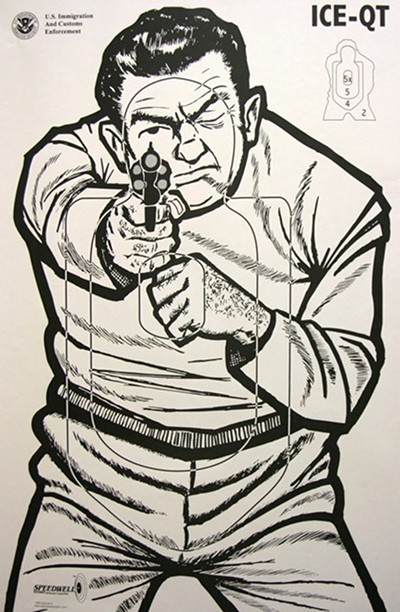 How to Fire a Handgun Safely and Correctly
How to Fire a Handgun Safely and Correctly -
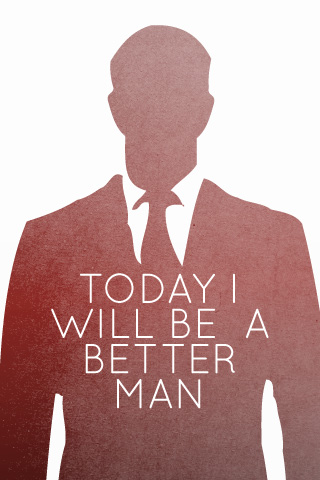 17 Free Inspirational and Manly iPhone Backgrounds at Primer Magazine
17 Free Inspirational and Manly iPhone Backgrounds at Primer Magazine -
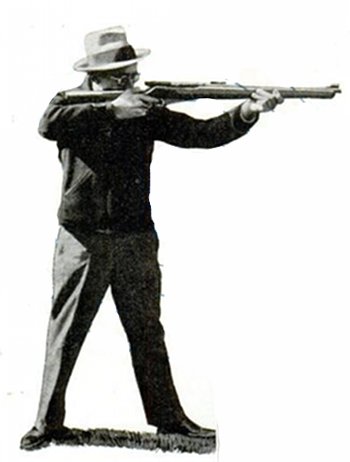 How to Shoot a Rifle
How to Shoot a Rifle -
 A Primer on the Ax: How to Use an Ax Safely and Effectively
A Primer on the Ax: How to Use an Ax Safely and Effectively -
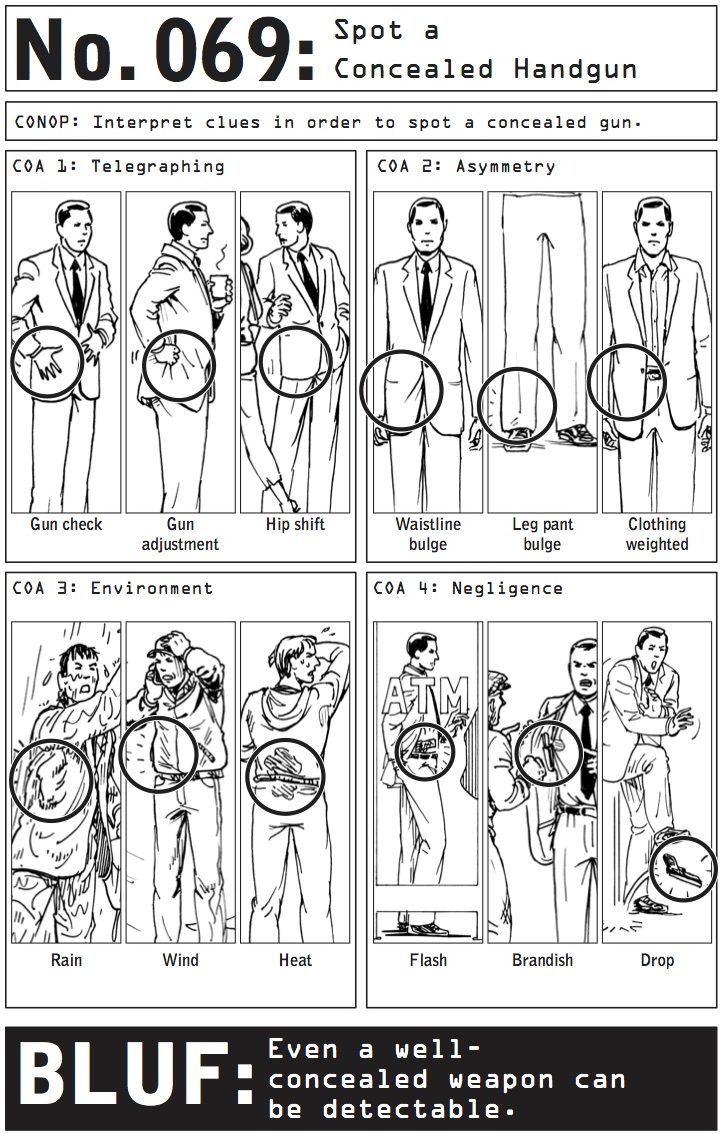 How to Spot a Concealed Handgun
How to Spot a Concealed Handgun -
 A Primer on the Ax: How to Choose the Right Ax for You
A Primer on the Ax: How to Choose the Right Ax for You -
 How to Fire a Handgun Safely and Correctly
How to Fire a Handgun Safely and Correctly -
 17 Free Inspirational and Manly iPhone Backgrounds at Primer Magazine
17 Free Inspirational and Manly iPhone Backgrounds at Primer Magazine -
 How to Shoot a Rifle
How to Shoot a Rifle -
 A Primer on the Ax: How to Use an Ax Safely and Effectively
A Primer on the Ax: How to Use an Ax Safely and Effectively -
 How to Spot a Concealed Handgun
How to Spot a Concealed Handgun -
 A Primer on the Ax: How to Choose the Right Ax for You
A Primer on the Ax: How to Choose the Right Ax for You
Self-Defense & Fighting PreviousNext
Literally Mindblowing Gameplay. 15 to 20-minute intense playtime. Enter the arena, go three rounds against The Dealer, and walk away with the prize.
This site only collects related articles. Viewing the original, please copy and open the following link:A Primer on the Shotgun The Art of Manliness

